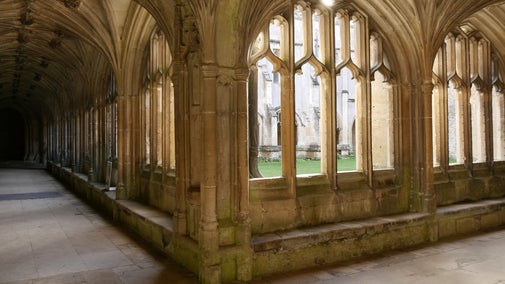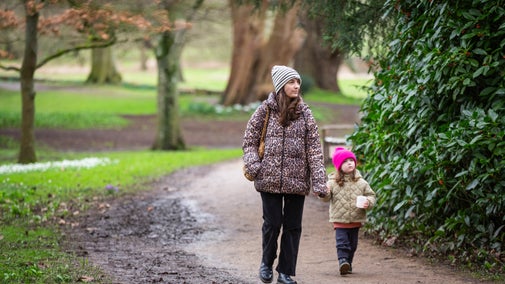
Volunteer with us
Search for live volunteering opportunities, or register your interest with Lacock Abbey.

The team at Lacock Abbey are always busy behind the scenes making sure that it looks at its best for your visit and finding new ways to bring to life the things that make it so special. From dusting the chandeliers at great heights to inviting visitors to watch conservation in action, discover some of our varied work at Lacock Abbey.
Over a two-week period in autumn 2019 the conservation team at Lacock Abbey cleaned, catalogued and conserved over a thousand tiles dating back to the 1200s.
After hundreds of years of footfall, the variable British weather and poor storage conditions the tiles were in desperate need of conservation to save them from being damaged beyond repair.
Visitors to Lacock during this time were able to watch the work take place.
- Emma Hitchings, Senior Collections and House Officer
The Abbey’s collection of tiles contains medieval examples, dating from the 1200s to the 1400s, and Tudor tiles dating from the 1500s. The medieval tiles would have been used to decorate the historic cloister and the Tudor tiles were made specially for Sir William Sharington, who bought Lacock Abbey from King Henry VIII after the dissolution of the monasteries.

Many of the rooms in the Abbey are closed during the winter months to give Lacock's house team the chance to complete a deep clean. The age of the Abbey and the size of its collection means that this is no easy task.
Although some of the high ceilings can be reached with the help of a telescopic duster, in some rooms scaffolding is needed to access hard-to-reach areas and delicate objects such as chandeliers.
Once up high, the conservation team systematically move around the edges of the room, inspecting the ceiling, cornices and walls for damage or movement, and dusting high-level objects as they go. Some items, such as ceramics and glass, need a bit more attention and get a wet clean after
being dusted.
Dust doesn’t just look unsightly, it can also be harmful. Dust scratches surfaces, increases the chance of mould growth, promotes insect damage (bugs love to eat dust), and will chemically stick to objects forever if it’s not gently removed on a regular basis.

Regular visitors to Lacock Abbey will be familiar with the striking clock tower in the Tudor Courtyard. Its mechanism dates from 1880 and is gravity run; two weights slowly drop over seven to eight days, providing the momentum to turn. The weight on the left controls the clock’s distinctive ‘dongs’ and the right weight controls the time.
Every week the Abbey team wind the weights back up and then check the time on the inner clock face, which is backwards to match the exterior clock face. If the clock has lost time, they adjust it accordingly by winding the minute hand around.
- Dave Hollis, Collections and House Officer
When it comes to the clocks going back, the team have to wind it through the full 12 hours, listening for the ‘dongs’ to make sure they have the right hour.
Traditionally, the clock was set five minutes fast to make sure the estate workers who lived in the village got to work on time and, today, the team are careful to keep the tradition going.
With your ongoing support, we're able to continue our vital conservation work. Thank you for helping to protect these special places.

Search for live volunteering opportunities, or register your interest with Lacock Abbey.
Three prized items in the collection at Lacock have been included in a special National Trust publication. Discover why they are so unique and where you can find them.

In its 800 years of history, Lacock has been an Augustinian abbey, a Tudor family home, a birthplace of photography, and a film and TV location.

Explore the historic streets of Lacock, a quintessential English village with timber-framed cottages and local shops. With its central grid of four streets, Lacock today looks much as it did 200 years ago.

Lacock Abbey's peaceful garden is a place to relax. Discover the Botanic Garden, greenhouse, orchard and woodland along with the sounds of nature at this green natural setting.

Seasonal blooms, activity trails, medieval architecture and photographic discovery: have a fun-filled adventure at Lacock Abbey. Watch the gardens change with the seasons and autumn colour come to life in the Woodland, and discover the nature and enjoy crafts and trail activities in October half term. Explore the abbey rooms and discover the window with a unique link to the invention of photography, find out more in the Fox Talbot Museum and feel inspired by the latest exhibition.

We believe that nature, beauty and history are for everyone. That’s why we’re supporting wildlife, protecting historic sites and more. Find out about our work.

Read about our strategy, which focuses on restoring nature, ending unequal access and inspiring more people.
